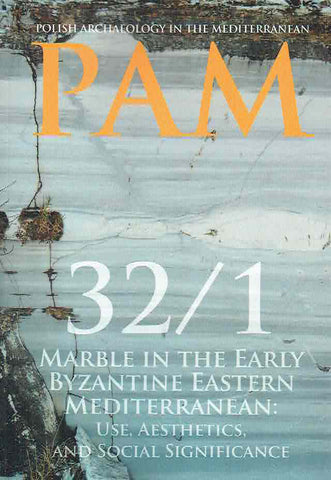Polish Archaeology in the Mediterranean 32/1, Marble in the Early Byzantine Eastern Mediterranean, Use, Aesthetics, and Social Significance
60,00 $
Description: softcover, 271 pp., (24x17cm), figs (drawings, phots.)
Condition: new
Weight: 560g.
Polish Archaeology in the Mediterranean 32/1, Marble in the Early Byzantine Eastern Mediterranean, Use, Aesthetics, and Social Significance, Polish Centre of Mediterranean Archaeology, University of Warsaw 2023
Foreword
Mariusz Gwiazda, Alessandro Poggio, and Dagmara Wielgosz-Rondolino
Early Byzantine vases carved in Prokonnesian marble from ancient Halasarna (Kos Island, Dodecanese, Greece)
Eirene Poupaki
Multiple stonecutters’ marks on marble in the Late Antique Mediterranean: Distribution, function, and meaning
Giulia Marsili
Corinthian capitals from the Hellespontus
Ayşe Çaylak Türker
Liturgical furnishings of the City Basilica at Patara (Lykia): Templon arrangement and its suggested reconstruction
Ceren Demirton
Use and aesthetics of Iasian marble in presbyteries of the 6th century
Diego Peirano
Between private and public: The use of marble in Late Antique Caesarea Maritima
Rivka Gersht, Peter Gendelman
Marmora Bizantina: A digital corpus of marble finds
from the southern Levant
Mariusz Gwiazda
Byzantine marble fragments rediscovered in a Tyre cistern
Hany Kahwagi-Janho
Marble as votive offering? Social agency in the post-Classical Levant
Basema Hamarneh
Methods of quantitative and qualitative analyses of ancient marble finds assemblages. The cases of early Byzantine Hawara, Porphyreon, and Philoxenite
Mariusz Gwiazda
The volume centers on the use of marble during the early Byzantine era (4th-7th century AD) across a broad expanse of the eastern Mediterranean region, encompassing the territories of Egypt, Arabia, Palestine, Phoenicia, Asia Minor, and Greece.
In antiquity, the term 'marble' had a broader meaning than it does today and was used to denote an array of hard stones suitable for polishing. Marble held significant importance as a material for sculpture and construction in the ancient world, often requiring importation due to its limited natural availability. Despite its crucial role, the specifics of marble use during the 4th to 7th centuries remain largely unexplored, prompting inquiries into the reasons behind its importation, distribution mechanisms, types of orders (whether private or imperial), and locations of display (whether public, like baths, or private, like residential buildings). Additionally, questions arise concerning the impact of large-scale construction projects, such as churches, on the importation of finished marble items or their local production from imported raw materials. This volume aims to address these gaps in research, shedding light on the significance of marble, its trade, aesthetics and social significance in the early Byzantine period.
While studies on marble usage in antiquity have flourished recently, the focus has primarily centered on the Greek and Roman periods. Although some significant papers on marble from later centuries have appeared in multi-authored publications, dedicated volumes specifically devoted to marbles of the early Byzantine era have been lacking.
The volume provides a comprehensive overview of marble utilization during the early Byzantine period, drawing on various approaches and methodologies. It not only showcases recent discoveries from significant sites but also offers insights into the social function and appreciation of marble. Several papers delve into the working processes of craftsmen and the rationale behind material selection for specific objects or building endeavors. Others offer detailed examinations, presenting a diverse array of marble objects within various contexts and through different analytical lenses.

